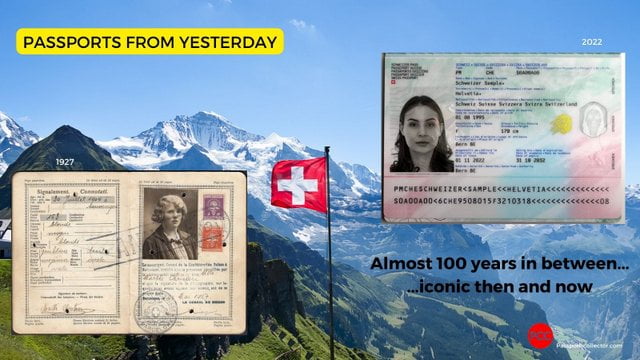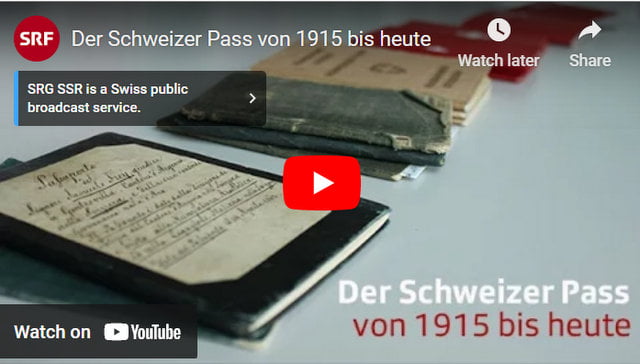How the Swiss passport became Red
To have a passport seems to us to be obvious. But the little booklet has yet existed a little over 100 years. And it was only around 50 years ago that the Swiss passport got his classic red color. The word “passport” is derived from the Latin “passare”, which means “to go through” or “to pass”. The development of the passport is closely linked to the history of the states and their relationship to each other.

Until the middle of the 15th century, it was mainly the letter of safe conduct or protection that was known in Europe. The letter of protection was issued for individuals, groups or goods and allowed a free passage through foreign territory. The issuing authorities often guaranteed a safe passage with the paper. The cover letter was thus something of an insurance policy for the transported goods. Such papers were issued exclusively to strangers and were not subject to citizenship. These passports were also a source of income for the exhibitor.
From safe conduct to passport letter
From the 15th century onward, the identification of the individual, or border control, came more and more to the fore. The passport letter was created, for example, to detect deserters at the border or to prevent the uncontrolled intrusion of “foreign rabble”. In contrast to the safe conduct, this document did not contain any right to protection. The passport letter was purely a permit to pass through and served above all to identify the owner – much more than his name was not to be found in these documents at the beginning.
The first register of persons maintained centrally by a state was launched in France on 29 September 1792. The law passed by the National Assembly at that time regulated the notarization of the civil status of citizens.
Clothes make the man
Over time, the information in the papers changed: In the 16th century, in the English kingdom, even the clothing was still noted in the passport. At that time, it was believed that the clothes would represent the stand or the position of the person and would always remain the same.
Since passports were issued irrespective of their origin and some of the exhibitors done a business out of them, it is said that in the 18th and 19th centuries, for example, there were many Englishmen who traveled with French papers as they were cheaper.
In the course of the 19th century, it became common to indicate age and stature in addition to the name. Furthermore, signal elements such as stature, face, hair, eye color, nose, nationality and place of birth entered the passport. Towards the end of the century, the entry of a fingerprint also came into fashion.
A passport for each canton
The passport as a personal identity card as we know it today was only created during the First World War. Issuing passports in Switzerland was a matter for the cantons until then.
However, these cantonal passports had more the function of a travel permit than an identity card in the present sense. There were no regular ID cards at that time. Passports containing only name, place of residence and nationality were issued in Switzerland as required.
First passport regulation
During the First World War, the passport was finally bound to citizenship, and the state took over the issuing of these documents. In Switzerland, on 27 November 1915, the Federal Council issued an “Ordinance on the use of a uniform passport form” valid throughout Switzerland. The uniform Swiss passports were issued from 10 December 1915. This first national identity card had a dark green cover.

How The Swiss Passport Became Red – Swiss Passport History
Red only since 1959
On 10 December 1928, the first “Federal Passport Ordinance” was issued, i.e. a uniform federal regulation of the entire passport system. As a result, all cantonal passport offices and all passport offices abroad were now subject to the same regulations.

On 26 August 1932, the color of the pass changed to light brown. Almost 30 years later, on August 1, 1959, the Swiss passport received its well-known red color and a white Swiss cross. In 1985, a new red passport was introduced – the last with a pasted photo – and on January 1, 2003, the machine-readable passport came into circulation.
Since September 2006, Switzerland has also been issuing an e-passport, passport 06.
The new Pass 10 has been available since 1 March 2010. This is equipped with a chip on which the fingerprints and a facial image are stored electronically (e-passport). This data increases the security of travel documents and makes their misuse more difficult.
As an associated Schengen state, Switzerland is obliged to issue only e-passports. The definitive introduction of a biometric Swiss passport represents an international obligation, the fulfillment of which should continue to ensure the freedom of travel of the Swiss.
The latest Swiss passport type was introduced in Oct 2022 and is iconic as ever.
Basics for the introduction of the biometric passport
Parliament laid the foundations for the definitive introduction of the biometric passport in summer 2008. On 17 October 2008, the referendum against this resolution was held, and on 17 May 2009 the voters accepted the bill. The definitive introduction of the biometric passport (passport 10) took place on 1 March 2010.

How The Swiss Passport Became Red – Swiss Passport History
FAQ Passport History
Passport collection, passport renewal, old passports for sale, vintage passport, emergency passport renewal, same day passport, passport application, pasaporte passeport паспорт 护照 パスポート جواز سفر पासपोर्ट
1. What are the earliest known examples of passports, and how have they evolved?
The word "passport" came up only in the mid 15th Century. Before that, such documents were safe conducts, recommendations or protection letters. On a practical aspect, the earliest passport I have seen was from the mid 16th Century. Read more...
2. Are there any notable historical figures or personalities whose passports are highly sought after by collectors?
Every collector is doing well to define his collection focus, and yes, there are collectors looking for Celebrity passports and travel documents of historical figures like Winston Churchill, Brothers Grimm, Johann Wolfgang von Goethe. Read more...
3. How did passport designs and security features change throughout different periods in history, and what impact did these changes have on forgery prevention?
"Passports" before the 18th Century had a pure functional character. Security features were, in the best case, a watermark and a wax seal. Forgery, back then, was not an issue like it is nowadays. Only from the 1980s on, security features became a thing. A state-of-the-art passport nowadays has dozens of security features - visible and invisible. Some are known only by the security document printer itself. Read more...
4. What are some of the rarest and most valuable historical passports that have ever been sold or auctioned?
Lou Gehrig, Victor Tsoi, Marilyn Monroe, James Joyce, and Albert Einstein when it comes to the most expensive ones. Read more...
5. How do diplomatic passports differ from regular passports, and what makes them significant to collectors?
Such documents were often held by officials in high ranks, like ambassadors, consuls or special envoys. Furthermore, these travel documents are often frequently traveled. Hence, they hold a tapestry of stamps or visas. Partly from unusual places.
6. Can you provide insights into the stories behind specific historical passports that offer unique insights into past travel and migration trends?
A passport tells the story of its bearer and these stories can be everything - surprising, sad, vivid. Isabella Bird and her travels (1831-1904) or Mary Kingsley, a fearless Lady explorer.
7. What role did passports play during significant historical events, such as wartime travel restrictions or international treaties?
During war, a passport could have been a matter of life or death. Especially, when we are looking into WWII and the Holocaust. And yes, during that time, passports and similar documents were often forged to escape and save lives. Example...
8. How has the emergence of digital passports and biometric identification impacted the world of passport collecting?
Current modern passports having now often a sparkling, flashy design. This has mainly two reasons. 1. Improved security and 2. Displaying a countries' heritage, icons, and important figures or achievements. I can fully understand that those modern documents are wanted, especially by younger collectors.
9. Are there any specialized collections of passports, such as those from a specific country, era, or distinguished individuals?
Yes, the University of Western Sidney Library has e.g. a passport collection of the former prime minister Hon Edward Gough Whitlam and his wife Margaret. They are all diplomatic passports and I had the pleasure to apprise them. I hold e.g. a collection of almost all types of the German Empire passports (only 2 types are still missing). Also, my East German passport collection is quite extensive with pretty rare passport types.
10. Where can passport collectors find reliable resources and reputable sellers to expand their collection and learn more about passport history?
A good start is eBay, Delcampe, flea markets, garage or estate sales. The more significant travel documents you probably find at the classic auction houses. Sometimes I also offer documents from my archive/collection. See offers... As you are already here, you surely found a great source on the topic 😉
Other great sources are: Scottish Passports, The Nansen passport, The secret lives of diplomatic couriers
11. Is vintage passport collecting legal? What are the regulations and considerations collectors should know when acquiring historical passports?
First, it's important to stress that each country has its own laws when it comes to passports. Collecting old vintage passports for historical or educational reasons is safe and legal, or at least tolerated. More details on the legal aspects are here...
Does this article spark your curiosity about passport collecting and the history of passports? With this valuable information, you have a good basis to start your own passport collection.
Question? Contact me...


